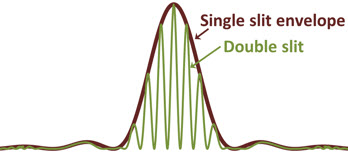When double-slit diffraction occurs, there are interference patterns inside, say, the central diffraction maxima (or envelope). I am trying to understand how these interference fringes are created.

Here is what I know: each individual slit in the double-slit setup produces a diffraction pattern, and these two diffraction patterns overlap very closing. Assuming Fraunhofer diffraction (the diffraction pattern is viewed far from the diffracting slits), the waves coming from each slit into the central diffraction envelope will interference and produce a series of bright and dark fringes.
My question: can someone explain “easily” how these overlapping diffraction patterns produce interference fringes inside a diffraction envelope?
I feel comfortable mathematically integrating the fields using the Fresnel diffraction integral to arrive at the Fraunhofer condition. When I say easily, I am looking for a more physical explanation if possible.
